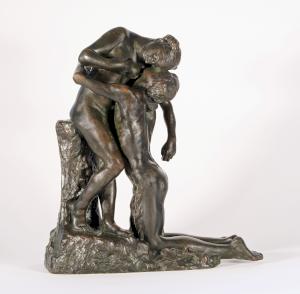Camille Claudel (1864 - 1943)
Born in Fère-en-Tardenois, Camille Claudel was the daughter of an administrator. She began sculpting in her adolescence, and when she made the acquaintance of the sculptor Alfred Boucher (1850-1934), he agreed to become her professor. When the family moved to Paris in 1881, she was able to take courses at the Académie Colarossi. The following year, she got her own studio, which she shared with some friends. She was then introduced to the director of the Ecole Nationale Supérieure des Beaux-Arts, Paul Dubois, and showed the plaster of The Old Helen at the Salon de la Société Nationale des Artistes Français.
In 1883, aged 19, she met Rodin, who was the replacement for her professor Alfred Boucher, who had left to travel in Italy. She entered Rodin’s studio as an assistant and became one of his models, and then his mistress. In 1884, she made a very beautiful bust of her brother Paul, titled My Brother as a Young Roman. In 1888, she met Claude Debussy, moved to the boulevard d’Italie, and received an honorable mention for her plaster of Sakountala, shown at the Salon de la Société Nationale des Artistes Français.
During the following decade—1888-1898—she did a great deal of work, including Young Girl with a Bun (1888), Bust of Auguste Rodin (1889), The Young Girl with a Bouquet (1889), a study for The Waltz (1892), Clotho (1893), The Little Chatelaine (1893), The Conversation (or Women Talking) (1894), The Mature Age (1895), and The Wave (1897). She showed regularly at the Société Nationale des Beaux-Arts, which Rodin had helped found in 1889.
She broke with Rodin in 1898 and, in 1900, met Eugène Blot, the artisan who did her casting and her faithful supporter. She continued to work prolifically, sculpting Perseus and the Gorgon in 1898, The Hamadryad in 1900, The Siren in 1904, and Vertumnus and Pomona in 1905. Her brother Paul wrote the article « Camille Claudel Sculptor » for The Occident in 1905, and she had a show a few months later with Bernard Hoetger in Eugène Blot’s gallery.
From 1906 on, she began exhibiting symptoms such as rages, bouts of destroying her works, and a preference for solitude linked to paranoia, that led to her being institutionalised in 1913. Nonetheless, she continued to show at Eugène Blot’s in 1907 and 1908. After thirty years in an institution, she died in 1943. The most representative of her works have been on display in a room in the Rodin museum in Paris since it opened in 1919. Mathias Morhardt suggested the idea, and Rodin warmly supported it.




